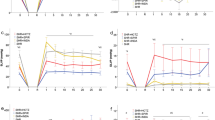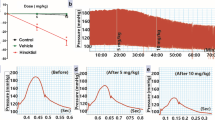Abstract
Seven spontaneously hypertensive rats (SHRs) and eight Wistar-ST rats were used to assess the influence of hemorrhage on myocardial and hepatic energy metabolism. They received 2% halothane and pancuronium, 0.3 mg·kg−1, during preparation. After discontinuation of halothane, blood (2 ml·100g body welght−1) was gradually withdrawn over a 5 min period from a femoral artery. Thirty min after induction of hemorrhage, the heart and liver were removed and myocardial and hepatic metabolites (ATP, lactate, pyruvate and glycogen) were measured by the enzymatic methods. Acidosis and decreased hematocrit were noted in the both groups after hemorrhage. Mean arterial pressure (MAP) in SHR was significantly higher than that in Wistar rat before hemorrhage. However, there were no significant differences in MAP and heart rate between the two groups after hemorrhage. Although there were no significant differences in cardiac metabolites, a significant decrease of hepatic ATP and an increase of hepatic lactate/pyruvate ratio were found in SHR when compared with Wistar rat. These results suggest that human hypertensive disease may run a high risk in connection with acute hemorrhage.
Similar content being viewed by others
References
Trippodo NC, Frohlich ED: Similarities of genetic (spontaneous) hypertension: man and rat. Cir Res 48:309–319, 1981
Halll CE, Ayachi S, Hall O: Differential sensitivity of spontaneously hypertensive (SHR) and control rats to various anaesthetic agents. Clin Exp Pharmacol Physiol Suppl, 3:83–86, 1976
Willis LR, Queener SF: Pentobarbital sleeping time and waking blood levels in spontaneously hypertensive rats. Can J Physiol Pharmacol 55:1205–1207, 1977
Smith TL, Hutchins PM: Anesthetic effects on hemodynamics of spontaneously hypertensive and Wistar-Kyoto rats. Am J Physiol 238:H539-H544, 1980
Hagberg H, Haljamäe H, Johansson B, et al: Liver and skeletal muscle metabolism, extracellular K+ concentrations, and survival in spontaneously hypertensive rats following acute blood loss. Circ Shock 10:61–67, 1983
Wennberg E, Hagberg H, Haljamäe H: The response of the awake spontaneously hypertensive rat (SHR) to acute blood loss. Acta Anaesthesiol Scand 28:457–461, 1984
Burke MJ, Stekiel WJ, Lombard JH: Reduced venoconstrictor reserve in spontaneously hypertensive rats subjected to hemorrhagic stress. Circ Shock 14:25–37, 1984
Bond RF, Johnson III G: The influence of hypotension upon the normal cardiovascular responses to hemorrhagic hypotension and shock. Experientia 41:607–609, 1985
Lombard JH, Roman RJ: Assessment of muscle blood flow by laser-Doppler flowmetry during hemorrhage in SHR. Am J Physiol 259:H860-H865, 1990
Bergmeyer HU: Neue Werte für die molaren Extinktions-Koeffizienten Von NADH und NADPH zum Gebrauch im Routine-Laboratorium. Z Klin Chem Klin Biochem 13:507–508, 1975
Werner W, Rey H-G, Wielinger H: Über die Eigenschaften eines neuen Chromogens für die Blutzuckerbestimmung nach der GOD/POD-Methode. Z Anal Chem 252:224–228, 1970
Judy WV, Farrell SK: Arterial baroreceptor reflex control of sympathetic nerve activity in the spontaneously hypertensive rat. Hypertension 1:605–614, 1979
Kopin IJ, McCarry R, Yamaguchi I: Plasma catecholamines in human and experimental hypertension. Clin Exp Hypertension 2:279–294, 1980
Hermsmeyer K: Cellular basis for increased sensitivity of vascular smooth muscle in spontaneously hypertensive rats Cir Res 38 (Suppl II):53–57, 1976
Mulvany MJ, Aalkjaer C, Christensen J: Changes in noradrenaline sensitivity and morphology of arterial resistance vessels during development of high blood pressure spontaneously hypertensive rats. Hypertension 2:664–671, 1980
Wennberg E, Hagberg H, Haljamäe, H, et al: Effects of hemorrhagic hypotension on brain and liver metabolism in normotensive (WHY) and spontaneously hypertensive rats (SHR). J Hypertension 1:221–226, 1983
Jakschick BA, Garland RM, Kourik JL, et al: Profile of circulating vasoactive substances in hemorr-hagic shock and their manipulation. J Clin Invest 54:842–852, 1974
Strawitz JG, Hift H, Ehrhardt A, et al: Irreversible hemorrhagic shock in rats: changes in blood glucose and liver glycogen. Am J Physiol 200:261–263, 1961
Author information
Authors and Affiliations
About this article
Cite this article
Kashimoto, S., Nonaka, A., Nakamura, T. et al. Cardiac and hepatic metabolism in spontaneously hypertensive rats following acute blood loss. J Anesth 6, 284–288 (1992). https://doi.org/10.1007/s0054020060284
Received:
Accepted:
Issue Date:
DOI: https://doi.org/10.1007/s0054020060284




